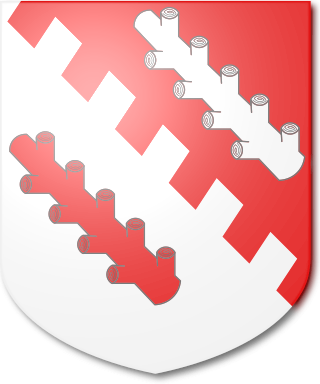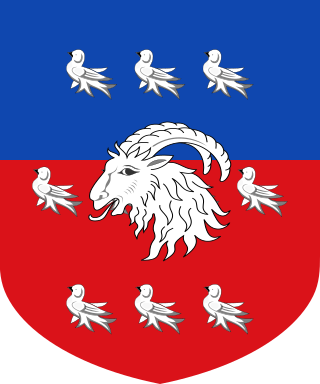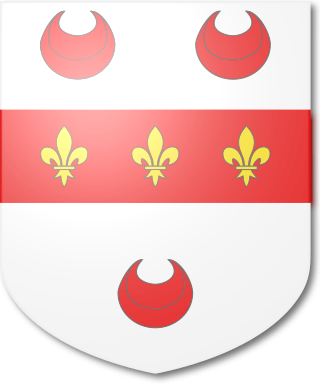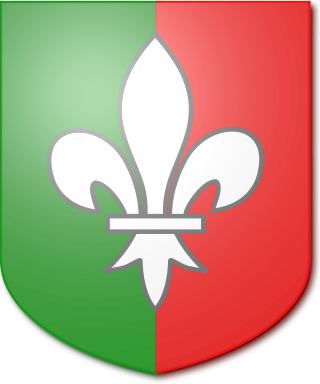
The Cradock-Hartopp Baronetcy, of Freathby in the County of Leicester and of Four Oaks Hall in the County of Warwick, was a title in the Baronetage of Great Britain. It was created on 12 May 1796 for Edmund Cradock-Hartopp, Member of Parliament for Leicestershire. Born Edmund Bunney, he was the husband of Anne Hurlock, granddaughter and heiress of Sir John Hartopp, 4th Baronet, of Freathby. On his marriage in 1777 he assumed the surname of Cradock-Hartopp in lieu of his patronymic according to the wills of his uncle Joseph Cradock and his wife's grandfather. His eldest surviving son Edmund, the second Baronet, died childless and was succeeded by his younger brother, William, the third Baronet. The title then descended from father to son until the death of his grandson, Charles, the fifth Baronet, in 1929.

The Boyle Baronetcy, of Ockham in the Parish of Salehurst in the County of Sussex, is a title in the Baronetage of the United Kingdom. It was created on 14 December 1904 for Edward Boyle, a barrister, businessman and Conservative Member of Parliament for Taunton. His grandson, the third Baronet, was also a Conservative Member of Parliament and ultimately cabinet minister serving as Minister of Education from 1962 to 1964. He was made a life peer as Baron Boyle of Handsworth, of Salehurst in the County of Sussex, in 1970 and became vice-chancellor of the University of Leeds in the same year. The life peerage became extinct on his death in 1981 and he was succeeded in the baronetcy by his younger brother, the fourth Baronet. As of 2023 the title is held by the latter's eldest son, the fifth Baronet, who succeeded in 1983.

There have been two baronetcies created for the Guise family, one in the Baronetage of England and one in the Baronetage of Great Britain. The latter creation is extant as of 2014.

The Broadbent Baronetcy, of Longwood in the Parish of Huddersfield in the West Riding of the County of York, and of Brook Street, in the Parish of St George Hanover Square in the County of London, is a title in the Baronetage of the United Kingdom. It was created on 10 August 1893 for the noted physician William Broadbent. The title descended from father to son until the death of his grandson, the third Baronet, in 1987. The late Baronet was succeeded by his first cousin once removed, the fourth Baronet. He was the grandson of Walter Broadbent, third son of the first Baronet.

The Boord Baronetcy, of Wakehurst Place in the County of Sussex, is a title in the Baronetage of the United Kingdom. It was created on 18 February 1896 for the Conservative politician Thomas Boord. His eldest son, the second Baronet, died unmarried in 1928 and was succeeded by his nephew, the third Baronet. He was the son of Alexander Edgar Boord, third son of the first Baronet. The third Baronet's eldest son, the fourth Baronet, succeeded in 1975. On his death in 2019, the title passed to his nephew Andrew, an Istanbul-based translator and business development consultant.

The Crisp Baronetcy, of Bungay in the County of Suffolk, is a title in the Baronetage of the United Kingdom. It was created on 5 February 1913 for the lawyer and microscopist Sir Frank Crisp.

The Millais Baronetcy, of Palace Gate in Kensington in the County of Middlesex and of St Ouen in Jersey, is a title in the Baronetage of the United Kingdom. It was created on 16 July 1885 for the painter and illustrator John Everett Millais. He was one of the founders of the Pre-Raphaelite Brotherhood. As of 2014 the title is held by his great-grandson, the sixth Baronet, who succeeded his father in 1992.

The Wiggin Baronetcy, of Metchley Grange in Harborne in the County of Stafford and of Garth Gwynion in Machynlleth in the County of Montgomery, is a title in the Baronetage of the United Kingdom. It was created on 17 June 1892 for Henry Wiggin. He was the founder of Henry Wiggin and Co Ltd, manufacturers of specialty metal products, and also represented Staffordshire East and Handsworth in the House of Commons. The second Baronet was High Sheriff of Staffordshire in 1896. The third Baronet was a colonel in the army and served as High Sheriff of Warwickshire in 1942. The fourth Baronet was high sheriff of Warwickshire from 1975 to 1976 and a deputy lieutenant of the county in 1985.

The Edwards-Moss Baronetcy, of Roby Hall in the parish of Huyton-cum-Roby in the County Palatine of Lancaster, is a title in the Baronetage of the United Kingdom. It was created on 23 December 1868 for Thomas Edwards-Moss. Born Thomas Moss, he had assumed by Royal licence the additional surname of Edwards in 1851, having married Amy Charlotte, daughter and heiress of Richard Edwards of Roby Hall, Lancashire. The presumed fifth Baronet does not use his title. As of 2021 he had not successfully proven his succession, and is therefore not on the Official Roll of the Baronetage, with the baronetcy considered dormant.

The Oakeley Baronetcy, of Shrewsbury, is a title in the Baronetage of Great Britain. It was created on 5 June 1790 for the Indian administrator Charles Oakeley. He served as Governor of Madras from 1790 to 1794. Frederick Oakeley was the second son of the first Baronet.
The Hartwell Baronetcy, of Dale Hall in the County of Essex, is a title in the Baronetage of the United Kingdom. It was created on 26 October 1805 for Admiral Francis Hartwell.

The Levinge Baronetcy, of High Park in the County of Westmeath, is a title in the Baronetage of Ireland. It was created on 26 October 1704 for Richard Levinge, Speaker of the Irish House of Commons and Lord Chief Justice of the Irish Court of Common Pleas. The seventh Baronet sat as Liberal Member of Parliament for Westmeath from 1857 to 1865.

The ffolkes Baronetcy, of Hillington in the County of Norfolk, is a title in the Baronetage of Great Britain. It was created on 26 May 1774 for Martin ffolkes, FRS later High Sheriff of Norfolk and Member of Parliament for King's Lynn. The second Baronet represented Norfolk and Norfolk West in the House of Commons while the third Baronet represented King's Lynn. The fifth Baronet was Honorary Chaplain to Queen Victoria, Chaplain-in-Ordinary to Edward VII and George V and Chaplain to Edward VIII and George VI.

The Rycroft Baronetcy, of Calton in the County of York, is a title in the Baronetage of Great Britain. It was created on 22 January 1784 for Reverend Richard Rycroft. Born Richard Nelson, he was the only surviving son of John Nelson, and had assumed by Royal sign-manual the surname of Rycroft in lieu of his patronymic in 1758. The fifth Baronet was high sheriff of Hampshire in 1899. The sixth Baronet was high sheriff of Hampshire in 1938.

The Poore Baronetcy, of Rushall in the County of Wiltshire, is a dormant title in the Baronetage of Great Britain. It was created on 8 July 1795 for John Methuen Poore, with remainder, failing heirs male of his own, to his brother Edward Poore and the heirs male of his body.

The Milman Baronetcy, of Levaton-in-Woodland in the County of Devon, is a title in the Baronetage of Great Britain. It was created on 28 November 1800 for Francis Milman, Physician-in-Ordinary to King George III and President of the Royal College of Physicians. The seventh Baronet was a brigadier-general in the British Army.

The Smith, later Smith-Marriott Baronetcy, of Sydling St Nicholas in the County of Dorset, is a title in the Baronetage of Great Britain. It was created on 1 June 1774 for John Smith, High Sheriff of Dorset in 1772. The second Baronet married Elizabeth Anne, daughter of Reverend James Marriott. The fourth Baronet assumed by Royal sign-manual the additional surname of Marriott. The fifth Baronet was High Sheriff of Dorset in 1873.

The Hoghton or Houghton, later Bold-Hoghton, later de Hoghton Baronetcy, of Hoghton Tower in the County of Lancashire, is a title in the Baronetage of England. It was created on 22 May 1611 for Richard Hoghton, Member of Parliament for Lancashire. The Hoghton family had been landowners in Lancashire since the reign of King Stephen and had been Knights of the Shire for Lancashire since the 14th century. The second Baronet represented Clitheroe and Lancashire in the House of Commons and was a Royalist leader during the Civil War. The third and fourth Baronets both sat as Members of Parliament for Lancashire. The fifth Baronet was Member of Parliament for Preston and East Looe while the sixth and seventh Baronets represented Preston. The eighth Baronet assumed the additional surname of Bold. In 1892 the ninth Baronet resumed, by Royal licence, the ancient family surname of de Hoghton.

The Fleming, later le Fleming Baronetcy, of Rydal in the County of Westmorland, is a title in the Baronetage of England. It was created on 4 October 1705 for William Fleming, Member of Parliament for Westmorland. The second Baronet was Bishop of Carlisle. The third Baronet represented Cumberland in the British House of Commons. The fourth Baronet was Member of Parliament for Westmorland. He assumed the surname of le Fleming, an ancient version of the family surname. This version of the surname has also been borne by the Baronets from the seventh Baronet onwards. The sixth Baronet, an ordained priest, served as Rector of Windermere.
Sir Charles Buckworth-Herne-Soame, 9th Baronet (1830-1906) was a baronet in the Baronetage of England, the ninth of the Buckworth-Herne-Soame baronets of Sheen in the County of Surrey.


















